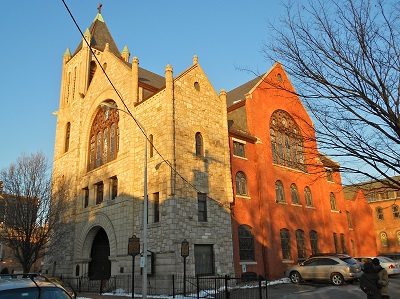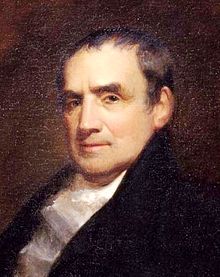Mother Bethel A.M.E. Church:
Page IV

Yellow Fever
Before St. Thomas's was completed, the Yellow Fever epidemic of 1793 intervened. The great plague decimated Philadelphia, killing 5,000 of its 50,000 inhabitants. Dr. Benjamin Rush and Mayor Matthew Clarkson asked Allen and Jones for their help in fighting the dread disease. It was thought that blacks were less likely to get the fever, but this is, of course, not true.
National Heritage Site Dedicated to Philadelphia's Free Black Community: Bethel Burying Ground: click for more info
x
National Heritage Site Dedicated to Philadelphia's Free Black Community: Bethel Burying Ground
At the time of the United States' founding and throughout much of the 19th century, Philadelphia was home to the largest free black population in the nation. This community built many founding black institutions and was among the most vocal in the fight for civil rights.
On, June 12, 2018, a new memorial site, Bethel Burying Ground, was dedicated as a National Historic site. Created in 1810, the site is the final resting place for nearly 5,000 people of African descent, many who lived ordinary lives among Philadelphia free blacks. Their stories reveal the many challenges that blacks faced even in a free state. Among the stories is that of Levi Ganges, who was one of 134 Africans who were captured in Africa and transported across the Atlantic. Levi eventually found his freedom in Philadelphia through the intervention of a U.S. naval captain, Judge Richard Peters, and the Pennsylvania Abolition Society.
The cemetery itself represents the hardships blacks faced in having a place to bury their dead. Mother Bethel Church, founded by Richard Allen in 1794, established the burial site. The church itself is also designated as a National Heritage site.
The pair overcame their dread fear and "found freedom to go forth, confiding in Him who can preserve in the midst of a burning, fiery furnace." They found in the first house they visited two children huddled with their feverish father, their mother already a victim. Jones and Allen found people to care for the children and tried to aid the sick father. A score more visits awaited the preachers in that first day alone. In the following weeks Allen organized dead-removal crews and continued to assist doctors. Allen was even taught by Benjamin Rush how to "bleed" fever victims, the treatment thought most efficacious by the eminent physician.

Portrait of Mathew Carey
John Nagle, 1825
Despite their best efforts, Jones and Allen were the subject of a bilious attack by Mathew Carey (whose name is associated with America's oldest publishing house) who accused blacks of profiting financially from Yellow Fever. According to Carey, Allen's crew of blacks overcharged for body removal and stole goods from the houses they entered. Mayor Clarkson and Richard Allen took out ads in newspapers denouncing Carey and his accusations.
Bethel Church
Ironically the Yellow Fever epidemic allowed black and white Philadelphians to see Allen's altruistic soul in action. Tensions between Allen and St. George's cooled — and he received permission from them to build a church on the site where he purchased the land for St. Thomas's years earlier. While funds were being raised to build a permanent structure, Allen bought a blacksmith shop from a fellow named Sims and had it hauled by a team of his own horses to 6th and Lombard. Bishop Asbury presided over the church's dedication on July 29, 1794. Reverend Dickins of St. George's suggested the name Bethel, meaning "the house of the Lord." Years later, W.E.B. DuBois called Mother Bethel, "by long odds the vastest and most remarkable product of American Negro civilization."
Allen and His Critics
Allen still had his critics. William Douglass, a pastor at St. Thomas's, said Methodism "appealed chiefly to the feelings and affectations which are always strongest among undisciplined minds." Moreover, the blacks who remained at St. George's after the 1787 schism accused Allen of segregating the race. Then there was the constant struggle with trustees at St. George's who attempted to control Mother Bethel's affairs. In 1796, for instance, St. George's wanted Bethel's property to pass to the Methodist conference. A trustee from St. George's by the name of Ezekiel Cooper tricked Richard Allen into signing over Bethel's land during incorporation. In 1807, members of Bethel drew up what Allen called the African Supplement, which attempted to throw off the yoke of St. George's. The Supplement gave trustees, "the right to nominate and appoint one or more persons of the African race to exhort and preach in Bethel Church and any other church which may hereafter become the property of the corporation..."
Despite these conflicts, Bethel grew. In its first two years, membership mushroomed from 20 to 121. Thanks to Allen's insistence on education Bethel had a children's day school and an adult night school on premises soon after its founding. In 1799, Richard Allen was ordained a deacon.
Slave Speculator
One day in 1808, a slave speculator came to the Bethel church door with a constable saying that Allen was a runaway slave. Slave speculators were a breed of men who bought the rights to escaped slaves, captured them, and resold them in the South. Other speculators would simply kidnap free blacks and sell them into slavery. This was a particularly simple-minded slave speculator, as most of Philadelphia would vouch that Richard Allen lived in the city for nearly 20 years and had not escaped from the South just a few years earlier as the speculator claimed. Allen sued the speculator for false accusation and perjury. The man could not make the $800 bail and was thrown into the Walnut Street Prison. From then on Allen redoubled his efforts in helping runaway slaves.
The Underground Railroad
Richard Allen preached abolition. One weapon he used in fighting slavery was pamphlets. In a pamphlet addressed to slave-owners, Allen claimed bondage was anti-American and anti-Bible. In another pamphlet addressed to blacks he exhorted all freed black men to help their enslaved brethren by being exemplary citizens and offering direct assistance.
As early as 1795, Allen helped 30 recently freed Jamaican slaves who had newly arrived in Philadelphia. It fell upon Allen to take care of them by finding housing and providing food.
As some point, the church's basement was used as a stop on the Underground Railroad (a network of houses creating a link from the south to Canada, where escaped slaves would be allowed to remain free). Aided in great part by his wife Sarah, Allen would hide, feed and clothe escaping slaves. Large sums of money were collected in order to facilitate a slave's flight to freedom. Some current members of the Mother Bethel AME church are descendants of those who were escaped slaves assisted by Mother Bethel.



